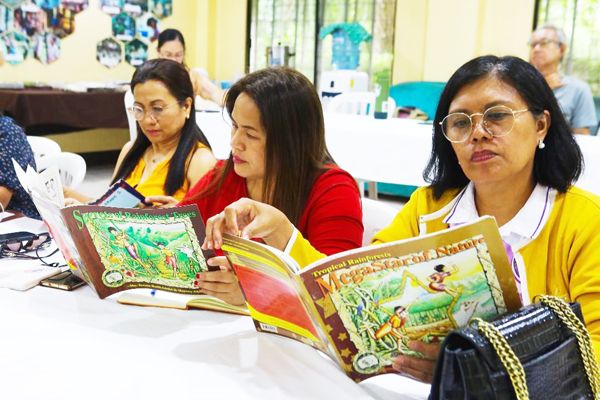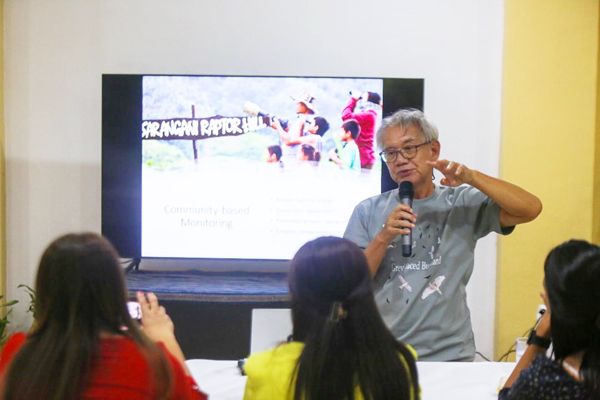DepEd-Sarangani to integrate Philippine Eagle lessons in Matatag curriculum
DAVAO CITY – The Department of Education-Sarangani is set to integrate Philippine Eagle conservation and biodiversity lessons into the Matatag curriculum to instill environment conservation values among the young generation.

DEPED Sarangani officials review the learning materials at Philippine Eagle Center. (Keith Bacongco)
As initial step, key officials of DepEd-Sarangani underwent an orientation on Philippine Eagle conservation initiatives at the Philippine Eagle Center in Barangay Malagos here on August 21.
Sarangani Schools Division Superintendent Dr. Ruth Estacio said that the integration of Philippine Eagle lessons is vital in the province since it is one of the home of the critically-endangered raptor.
Estacio believes that it is very important to instill conservation values and care for the wildlife among the children while they are still young. She also believes that the younger generation could also help influence the adults in educating their respective communities on the impact of poaching activities to the wildlife.
During the orientation session, she pointed out that Philippine Eagle conservation lessons could be integrated in science and social studies lessons in Grades 1, 4, and 7.
Estacio said that proposed lessons will not just cover Philippine Eagle conservation lessons but also environment protection and other related topics.
The DepEd official acknowledged that poaching activities used to be prevalent in the mountainous areas of Sarangani.
According to the Philippine Eagle Foundation, there are pairs of eagles in the mountains of Kiamba, Maasim, and Maitum. Across the country, there are about 400 pairs left in the wild.
Dr. Donna Panes, chief of the Curriculum Implementation Division, said that they are looking to integrate the Philippine Eagle lessons by the third or fourth quarter this year.
Panes emphasized that there is an urgent call for awareness in conservation of wildlife due to recent incidents of shooting of Philippine Eagles using customized “jolen” guns.
She added that had majority of the population know the importance of wildlife role in biodiversity, there could be minimal, if none at all, shooting incidents.
“And we should start now, start educating and start it at early graders to build a strong foundation in taking care of our biodiversity,” Panes said.
PEF Director for Operations Dr. Jayson Ibañez acknowledged the vital role of the DepEd in educational awareness for the conservation of the country’s national bird.
Ibañez emphasized the importance of instilling conservation values to the younger generation.
He admitted that there were attempts more than a decade ago but it did not materialize for some complicated reasons.
The PEF has available learning materials that can be used as reference in designing the curriculum for public schools, Ibañez said.
He added that the teacher’s guide on Philippine Eagle conservation and biodiversity was produced in 2007 and were used in selected schools in regions where there are known eagle nesting sites such as Calabarzon, Caraga, and Davao.
The lesson integration program, however, ended in 2009.
Thus, Ibañez said that the PEF is optimistic that with the revival of the curriculum integration, it could perhaps change the perspective of the younger generation not just towards the Philippine Eagle but also toward other forms of wildlife and its habitats in Sarangani.
After the project with DepEd ended, the same learning materials were used as reference by PEF during information, education, and communication (IEC) sessions in some schools and communities.
Aside from PEF, the curriculum integration program in Saragani is also supported by the Sarangani Energy Corp. of Alsons Power Group.
Panes said the proposed integrated curriculum will be tested in the schools that are being supported by SEC.
Bird-watching activities
Aside from SEC, the Division of Saragani is also working with the Raptorwatch Network Philippines, which has been working with the communities in Glan town in Sarangani.
Raptorwatch Network Philippines founder Alex Tiongco suggested the inclusion of bird-watching activities in the curriculum.

TIONGCO (Keith Bacongco)
Tiongco and his group have been organizing bird-watching activities in the Sarangani Raptor Hill in Barangay Rio del Pilar in Glan.
He added that what started as a small migratory bird monitoring eventually became a community affair as residents are actively participating in any activities organized by the group.
Panes suggested that trekking and birdwatching be integrated into Philippine Eagle-related lessons.
Panes said students should be equipped with binoculars to enable them to fully appreciate the value of bird-watching.
Ibañez agreed that there should be enough binoculars or any related equipment for children to fully appreciate the beauty of birdwatching. “It will really make a difference among children if they would be able to appreciate birdwatching. Many are still not used to look up, the feeling is really different when you look up. Maluwang sa pakiramdam.”
The Division of Saragani plans to hold a curriculum writeshop in October. “If there are competencies that would align for the third and fourth quarter, maybe we can start implementing the lessons.”
Estacio emphasized that they will prioritize writers coming from the Indigenous Peoples communities in the province.
The Division of Sarangani has 320 schools serving the towns of Alabel, Glan, Kiamba, Maasim, Maitum, Malapatan, and Malungon. Over half of them are serving IP communities.
After their initial review of the learning materials from PEF, Panes said that the content is appropriate for integration to the Matatag curriculum.
However, they will just make some adjustments based on the context of Sarangani, she added.
The output of the writeshop will be reviewed by the Learning Resource Material Development Section under the Curriculum Implementation Division prior to implementation.